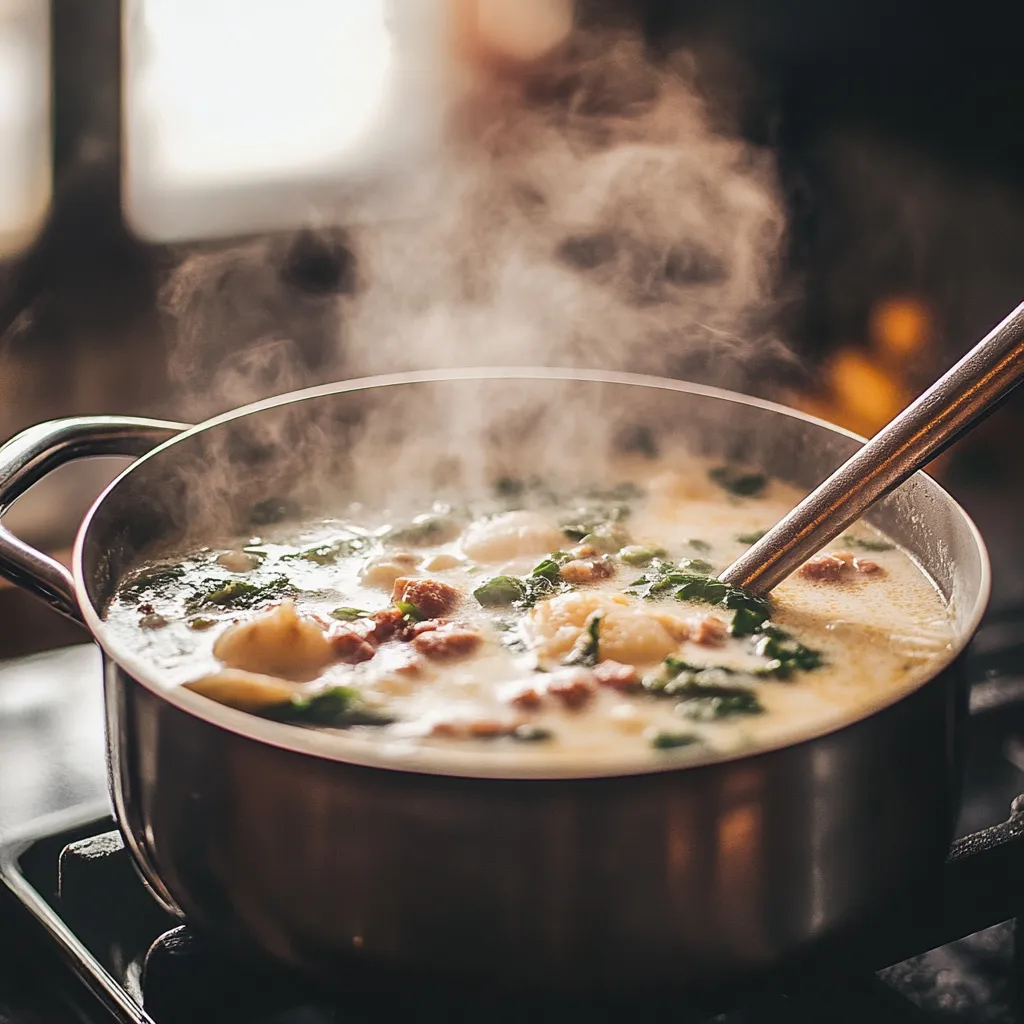Can You Freeze Zuppa Toscana? A Complete Guide to Freezing and Storing
Freezing soups like Zuppa Toscana is a hot topic for home cooks looking to save time and reduce food waste. But not every soup freezes the same. In this guide, we’ll break down how to freeze Zuppa Toscana properly, the best way to reheat it, and tips for keeping its creamy, rich flavor intact. By the end, you’ll feel confident preparing, freezing, and enjoying this beloved soup anytime.
To understand its origins, you might want to learn more about “what Zuppa means in Italy”. It’s fascinating to see how traditional recipes evolve into global favorites.
Table of Contents
Introduction to Freezing Zuppa Toscana
What Is Zuppa Toscana?
Zuppa Toscana, made famous by Olive Garden, is a hearty Italian-inspired soup. It blends tender potatoes, crumbled sausage, fresh kale, and a creamy broth. The mix of flavors makes it a crowd-pleaser, whether you’re serving a weeknight meal or a weekend feast.
It’s no wonder people want to make extra. But can you freeze it without losing that delicious texture and taste? The answer is yes—with a few easy tips.
Why Consider Freezing?
Freezing Zuppa Toscana is a smart way to save leftovers or batch-cook for busy weeks. By freezing it, you can stretch your cooking efforts further, prevent food from spoiling, and always have a comforting meal ready to go. Soups, in general, are freezer-friendly. However, the creamy base of Zuppa Toscana requires a bit more care.
So, what’s the secret? It’s all about the prep. Cooling, portioning, and choosing the right containers are crucial. Not only does this protect the flavor, but it also keeps the texture as close to fresh as possible.
How to Freeze Zuppa Toscana Properly
Prepping the Soup for Freezing
To freeze Zuppa Toscana successfully, the first step is letting it cool. Hot soup straight into the freezer can cause condensation, leading to ice crystals. Allow the soup to reach room temperature before portioning it into containers.
Next, choose sturdy, airtight containers or freezer bags. For freezer bags, lay them flat to save space. Make sure to leave a bit of room for the soup to expand as it freezes. This prevents leaks and keeps the soup fresh longer.
Lastly, consider portion sizes. Small portions are easier to thaw and reheat, especially for single servings or quick lunches.
Can You Freeze Dairy-Based Soups?
This is a common concern. Creamy soups like Zuppa Toscana can separate during freezing. While the soup is still safe to eat, the texture might change. Here’s the trick: if you’re making a fresh batch to freeze, hold off on adding the cream until reheating. Add it after thawing, giving your soup a fresh, velvety finish.
If your soup already has cream, don’t worry. Stirring it well during reheating can restore most of the creamy texture.
Best Practices for Freezing Zuppa Toscana
To keep your soup in tip-top shape, always use containers that seal tightly. Double-bagging freezer bags is another great way to avoid freezer burn. Label each portion with the date and contents, so you know exactly what’s in your freezer.
Try not to freeze the soup for more than 3 months. Over time, even the best-frozen soups can lose flavor.
Labeling and Storage Tips
A clear label can save you time. Write the name, date, and reheating instructions. For example: “Zuppa Toscana—add cream after thawing, use by [date].” Use a permanent marker to prevent smudging.
Arrange your containers or bags neatly in the freezer. Stack them flat to maximize space and keep everything organized.
| Ingredient | Quantity | Notes |
|---|---|---|
| Italian sausage | 1 lb (450 g) | Mild or spicy, crumbled |
| Russet potatoes | 4 medium | Peeled and diced |
| Kale | 2 cups (packed) | Chopped, stems removed |
| Chicken broth | 6 cups (1.5 L) | Low-sodium preferred |
| Heavy cream | 1 cup (240 ml) | Add after freezing if preparing for storage |
| Onion | 1 medium | Diced |
| Garlic cloves | 3 | Minced |
| Olive oil | 2 tbsp (30 ml) | For sautéing onions and garlic |
| Salt | 1 tsp (to taste) | Adjust as needed |
| Black pepper | 1/2 tsp | Freshly ground |
| Red pepper flakes (optional) | 1/4 tsp | For a slight kick |
| Parmesan cheese (optional) | To taste | Grated, for garnish |

How to Reheat Frozen Zuppa Toscana
Thawing Methods for Best Results
When you’re ready to eat, thawing frozen Zuppa Toscana properly is key. The best way is to move the frozen container to the refrigerator overnight. This slow method helps keep the soup’s flavor and texture intact.
In a pinch? You can thaw it in warm water. Place the container in a bowl of warm water and let it sit for 20–30 minutes. Once it loosens, transfer the soup to a pot for reheating.
Reheating Techniques
Stovetop reheating is the best way to warm up Zuppa Toscana. Use a medium-sized pot and heat the soup over medium heat, stirring often. This evenly distributes heat and prevents sticking.
Microwaving is quicker but requires care. Heat in short bursts and stir in between to avoid hot spots. If using a slow cooker, set it on low and allow the soup to warm gradually, which works great if you’re multitasking.
How to Adjust Consistency After Reheating
After freezing, some soups may thicken or lose their creaminess. If your Zuppa Toscana looks too thick, just add a splash of broth, milk, or cream. Stir gently and heat until everything blends well.
If the soup separated during freezing, don’t panic. Whisking it while reheating can often bring the ingredients back together.

FAQs About Freezing Zuppa Toscana
Can I Freeze Leftovers From the Fridge?
Yes, you can freeze Zuppa Toscana leftovers, but timing matters. It’s best to freeze the soup within 1–2 days of cooking to maintain freshness. Make sure the soup hasn’t been sitting out for hours, as this can compromise safety.
When freezing leftovers, use smaller containers for easier thawing and reheating. And remember: always label the containers with the date!
How Long Does Frozen Zuppa Toscana Last?
Frozen Zuppa Toscana can last up to 3 months in the freezer without losing much quality. Beyond that, the flavor may dull, and the texture might not be as good. For the best taste, aim to consume it within this time frame.
Are There Any Ingredients That Don’t Freeze Well?
Potatoes and kale, common ingredients in Zuppa Toscana, can sometimes change texture after freezing. Potatoes might become slightly grainy, and kale may soften more than you’d like. If this concerns you, consider undercooking these ingredients before freezing or adding fresh kale during reheating.
Benefits of Freezing Soups Like Zuppa Toscana
Save Time and Reduce Waste
Freezing Zuppa Toscana is a great way to make your meals stretch further. Instead of tossing leftovers, you can preserve them for busy days when cooking feels like a chore. Plus, having a pre-made meal ready to go can save you hours in the kitchen.
By freezing extra soup, you’re also cutting down on food waste. Every portion you freeze means less food ends up in the trash.
Enjoy Restaurant-Quality Soup Anytime
There’s something comforting about knowing you have a warm bowl of Zuppa Toscana waiting in your freezer. Whether you’re craving a quick lunch or a satisfying dinner, freezing this soup makes it easy to enjoy a restaurant-style meal at home.
Expert Tips for Freezing Soups
Choosing the Right Containers
When freezing Zuppa Toscana, the choice of containers matters. Airtight glass jars, sturdy plastic containers, or high-quality freezer bags work well. Glass jars are eco-friendly, while freezer bags save space by laying flat. Whatever you pick, make sure it seals properly to avoid freezer burn.
Leave some space at the top of the container for expansion. Liquids expand when frozen, and overfilled containers may crack or leak. Taking this small step prevents mess and keeps your soup safe.
Avoiding Common Mistakes
One common mistake is freezing hot soup. Always cool Zuppa Toscana to room temperature first. Hot soup in the freezer causes ice crystals to form, which can alter the texture.
Another pitfall is forgetting to label the containers. Write the date and contents on each container. For example, “Zuppa Toscana—freeze date [insert date].” Clear labels save time and reduce the guesswork when you’re searching through your freezer.
Lastly, don’t freeze large batches in a single container. Smaller portions thaw faster and give you more flexibility when reheating.
Creative Uses for Frozen Soup
Frozen Zuppa Toscana isn’t just for reheating as-is. Thaw it and transform it into a new dish! Use it as a base for pasta sauce, add cooked rice for a heartier meal, or turn it into a pot pie filling. Being creative with leftovers helps reduce waste and keeps your meals exciting.
Wrapping Up and Additional Resources
Why Freezing Zuppa Toscana Works
So, can you freeze Zuppa Toscana? Absolutely. With the right prep and storage methods, this soup stays delicious and ready to eat for months. Whether you’re saving leftovers or making a batch for meal prep, freezing Zuppa Toscana helps you enjoy it anytime without extra effort.
Freezing doesn’t have to be intimidating. With a few simple steps, you can keep your soup fresh and flavorful. Plus, having a ready-to-eat meal in the freezer is perfect for busy days.
Additional Recipes to Try
Love hearty soups? Don’t stop at Zuppa Toscana! Try other freezer-friendly options like chili, minestrone, or chicken noodle soup. For more meal ideas, check out Alexia Recipes’ Zuppa Toscana Pasta Recipe. It’s another creative spin on this classic dish!

